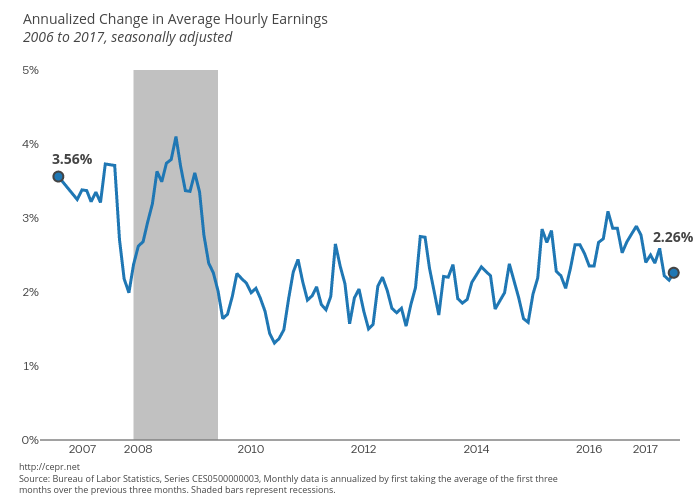August 04, 2017
August 4, 2017 (Jobs Byte)
By Dean Baker
The number of people choosing to work part-time hit a new high, likely as a result of the ACA.
The Bureau of Labor Statistics reported the economy added 209,000 jobs in July, somewhat more than the consensus estimated. The revisions to the prior two months data were largely offsetting, bringing the three-month average to 195,000. The strong job growth brought the unemployment rate back down to the 4.3 percent rate reached in May, the low for the recovery. There was also a slight uptick in the employment-to-population ratio (EPOP) to 60.2 percent, a new high for the recovery.
Some of the other data in the report were more mixed. While the single-month wage growth was strong at 9 cents per hour, this is a very erratic figure. The rate over the last 12 months was 2.5 percent. Furthermore, the average wage for the last three months compared with the prior three months grew at just a 2.3 percent annual rate. While this is a very modest deceleration, clearly it is not possible to make a case that wage growth is accelerating in spite of the relatively low unemployment rate. The average hourly wage for production nonsupervisory workers has risen just 2.4 percent over the last year, making the claims of labor shortages for less-educated works rather dubious.
The percentage of unemployment due to voluntary quits fell back to 10.9 percent. By comparison, this figure was over 12.0 percent in 2006 and 2007 and peaked at more than 15.0 percent in 2000. The low share of quits suggests that workers are not confident in their labor market prospects. The duration measures for unemployment spells also all edged up in July, with the median duration rising by a full week to 10.6 weeks and the average by 0.2 weeks to 24.9 weeks.
It is also worth noting that the data continue to refuse to comply with the skills shortage story. The employment rate for college grads actually fell 0.2 percentage points in July and is unchanged over the last year. By contrast, the employment rate for those with just a high school degree is up by 0.8 percentage points over the last year.
The job growth in July was heavily concentrated in a small number of sectors. Restaurants added 53,100 jobs, accounting for more than a quarter of the month’s gains. Health care added 39,400 jobs, considerably more than its 27,000 average over the last year. Administration and waste services added 30,000 jobs, more than half of which were accounted for by the 15,500 jobs in employment services.
Manufacturing added 16,000 jobs, with fabricated metals being the biggest gainer with 5,000 jobs. Construction added just 6,000 jobs, down from an average of 16,000 over the last year. The mining sector added just 1,200 jobs, with coal mining losing 200 jobs.
One positive item in the July data was a jump of 469,000 in voluntary part-time employment to 21,260,000, an all-time high. These are people who say they are working part-time by choice. While the monthly numbers are highly erratic, voluntary part-time employment has been on a strong upward path since the Affordable Care Act took full effect in January of 2014. It is now up by more than 2.4 million from its December 2013 level. At the same time, the number of people involuntarily working part-time is down by more than 2.5 million.
One very positive sign in this report was an increase of 0.2 percentage points in the EPOP for prime-age (ages 25 to 54) workers to 78.7 percent, an increase of 0.7 percentage points from the year-ago level. The EPOP for prime-age men is up by 0.4 percentage points, while the EPOP for prime-age women is up by a full percentage point over the last year. This suggests that workers are still coming back into the labor force.
In sum, this is a generally positive report showing that the economy is still adding jobs at a healthy pace. However, the weak wage growth indicates that employers are not feeling a need to raise wages. And, the fact that so much of the employment growth was in the low-paying restaurant sector indicates workers still do not have much choice in jobs. The low quit rate supports this picture.







